|
Have a safe day!
Friday, Dec. 10
3:30 p.m.
DIRECTOR'S COFFEE BREAK - 2nd Flr X-Over
4 p.m.
Joint Experimental-Theoretical Physics Seminar
-One West
Speaker: Yvonne Peters, University of Manchester/Fermilab
Title: A Top Quark Carol
Monday, Dec. 13
11 a.m.
Particle Astrophysics Seminar - (NOTE TIME) One West
Speaker: Shin’ichiro Ando, California Institute of Technology
Title: TBD
2:30 p.m.
Particle Astrophysics Seminar - One West
Speaker: Kyle Dawson, University of Utah
Title: TBD
3:30 p.m.
DIRECTOR'S COFFEE BREAK - 2nd Flr X-Over
4 p.m.
All Experimenters' Meeting - Curia II
Special Topics: JASMIN December Activation Experiments (T-972/993);
T-992: Rad-Hard Sensor Studies for the SLHC
Click here for NALCAL,
a weekly calendar with links to additional information.
Upcoming conferences
|
|
Friday, Dec. 10
- Breakfast: Chorizo burrito
- Old fashioned ham & bean soup
- Philly-style chicken
- Chicken pot pie
- Baked fish over rice
- Roasted veggie & provolone panini
- Assorted sliced pizza
- Carved baked ham
Wilson Hall Cafe Menu
|
|
Wednesday, Dec. 15
Christmas Lunch
12 p.m.
- Crab cakes w/red pepper mayo
- Lemon orzo
- Sautéed spinach w/ garlic
- Chocolate raspberry torte
Thursday, Dec. 16
Dinner
- Shrimp cocktail
- Prime rib
- Baked potato
- Steamed broccoli
- Chocolate mousse pie
Chez Leon Menu
Call x3524 to make your reservation.
|
|
A laboratory search for chameleon dark energy
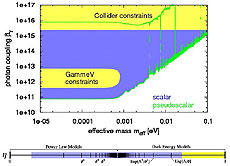 |
|
The figure shows limits on chameleons from previous experiments in yellow and from CHASE in blue (for scalar chameleons) or green outline (for pseudoscalar chameleons). The sensitivity to different chameleon models is shown in the horizontal bar at the bottom (previous results again in yellow with CHASE in blue). |
There is strong evidence that the expansion of the universe is accelerating, perhaps due to some form of dark energy. While its cause is not known, a common suspect for this dark energy is a new spinless (scalar) field.
One viable model for such a field is the chameleon model. The hypothesized chameleon particles are so named because they change their mass depending upon the local environment. In the vacuum of space, they have small masses and produce long-range forces. However, in the presence of ordinary matter, like a piece of glass or metal, the chameleons become much more massive and the mediated force is short ranged – too short to have appeared in searches for new forces.
The GammeV Chameleon Afterglow Search (CHASE) uses this mass-changing property to try to trap these chameleon particles for study. If low-energy chameleons are produced inside a vacuum chamber, they would be trapped in that chamber since their masses become too large to escape when they approach the chamber walls. In the CHASE experiment, housed at the Fermilab Magnet Test Facility, a laser beam shines down the bore of a spare Tevatron magnet. Suspected interactions between photons and chameleon particles within the magnetic field may produce a population of chameleon particles. Once this population is made, the laser is turned off, a photon detector is turned on, and the chameleons then reconvert to photons, escape the chamber, and leave an observable photon afterglow.
No chameleon afterglow signal was seen in the CHASE data, which allowed the collaboration to place new limits on chameleon models of dark energy. These limits span a range of nearly four orders of magnitude in chameleon mass and are nearly five orders of magnitude more stringent than previous bounds from collider experiments. CHASE data are sensitive to potential photon and chameleon couplings as small as 3.1 x 10-8 GeV-1 (an energy scale over 30,000 TeV).
These results will soon appear in Physical Review Letters. They currently appear in the arXiv pre-print server .
-- Jason Steffen
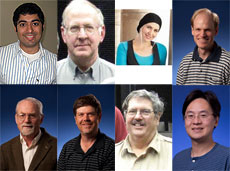 |
|
These GammeV-CHASE collaboration members. Top row, from left: Amol Upadhye, Ray Tomlin, Amanda Weltman and experiment spokesperson Jason Steffen. Bottom row from left: Peter Mazur, William Wester, Al Baumbaugh and Aaron Chou. |
|
Volunteer opportunity – children's winter gear
Donate hats, scarves, mittens and boots to local children ages 5-11. Fermilab's Diversity Council is organizing a volunteer effort to outfit boys and girls in grades K through 6 at Longwood Elementary School in Aurora with winter gear. Longwood Elementary School is one of seven elementary schools in Indian Prairie District 204 that receives Title I Targeted Assistance Grant program funding. A Title I school is one where free and reduced lunch percentages are above the district average. Title I funds aim to bridge the gap between low-income students and other students. The U.S. Department of Education provides supplemental funding to local school districts to meet the needs of at-risk and low income students.
Anyone who would like to participate can drop off items in collection boxes located on both sides of the 15th floor of Wilson Hall now through Jan. 12, 2011.
|
Landscape artist reception today in Fermilab Art Gallery
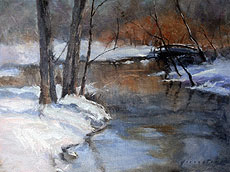 |
|
An oil painting entitled "Winter Stream" by landscape artist William Worcester. A reception for the Fermilab Art Gallery exhibit of Worcester's works will take place from 5-8 p.m. today. |
While Fermilab is covered in snow, a new art gallery exhibit might remind you of warmer seasons. Artist William Worcester’s oil painting exhibit, “Natural Light and the Landscape,” is a collection of landscapes at different times of the day and through all seasons. It will be displayed on the second floor crossover until Feb. 7.
A Batavia resident, Worcester paints many scenes from the Fox River Valley and local prairies. The gallery will even include a few scenes of Fermilab. Worcester said that he enjoys coming to the grounds to paint and photograph the prairie and ponds.
“I like the idea of undisturbed nature,” Worcester said. “We’re all a part of nature; I’m just part of nature recording nature.”
The paintings, he said, have a classic, realistic look in the tradition of George Ennis, Isaac Levitan and turn-of-the-century naturalists.
“They aren’t contemporary, but they have a worn and comfortable feeling,” Worcester said. “I like to bring back a time when people were out in nature and remind them of how good they felt being in that beauty.”
Fermilab Art Gallery Director Georgia Schwender thought that landscape art would be perfect for the Art Gallery.
“We thought all of his local scenes would be of interest to Fermilab’s employees," she said.
Worcester will hold a painting demonstration in the Art Gallery from 11:30 a.m. to 1 p.m. on Dec. 15, which will include a short presentation and questions and answers. Anyone who enjoys nature’s serenity and beauty, he said, is encouraged to attend.
The Fermilab Art Gallery will host a reception with Worcester from 5-8 p.m. on Friday, Dec. 10. More of Worcester’s work is available on his website.
-- Sara Reardon
|
|
Early exotica
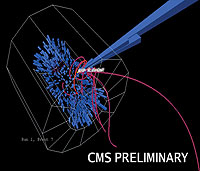 |
|
A gluino that decays inside the CMS calorimeter will leave a single blob of energy (big blue spike) with very little in the rest of the detector.
|
As CMS begins its long research program, it is natural to expect that the first results will be a confirmation of the well-known Standard Model. The more exotic findings come after it is clear that we understand how the known theory extends into the new energy regime and that our detector operates as expected. It is therefore perhaps surprising how quickly today’s analysis was performed.
One of the prime goals of the LHC physics program is to search for phenomena caused by a proposed principle called supersymmetry. A necessary feature of supersymmetric theories is that they predict that for all known subatomic particles, each particle should have a supersymmetric cousin, which differs in the details of how the particles spin.
Today’s analysis looked for a gluino, which is the gluon’s supersymmetric cousin. As if this weren’t exotic enough, this analysis looked for very long-lived gluinos, potentially existing for more than 15 minutes. In a field in which a lifetime of a millionth of a second is a long time, 15 minutes might as well be forever.
The idea behind this analysis is that gluinos would embed themselves inside more ordinary particles (similar to a proton or a pi meson). If the ordinary particle had an electric charge, it could slow and stop inside the CMS calorimeter. Physicists then looked for the decay of the gluino in periods when no collision could occur inside CMS. The signature would be a large amount of energy localized in the calorimeter.
Even with a tiny amount of recorded beam (about 2.5 percent of what is used in the most sensitive published Tevatron analysis,) CMS physicists were able to set the most stringent limits to date on this exotic idea.
- Don Lincoln
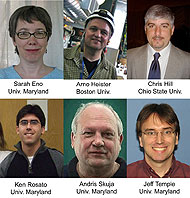 |
|
These physicists were the US contingent who performed this analysis, in collaboration with their overseas colleagues.
|
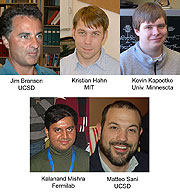 |
|
These physicists played a crucial role in CMS electron identification.
|
|
New employees - Nov. 29
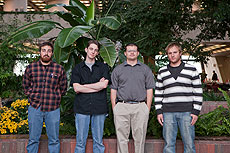 |
Dan Vrbos, AD; Mike Olander, AD; Adam Watts, AD; and Guillermo Fernandez Moroni, FCAB. Photo: Cindy Arnold |
|
Dark matter rush: Physics gives gold mine new life
From Wired.com, Dec. 9, 2010
LEAD, South Dakota — The gold rush glow has long faded from South Dakota, but a different kind of precious material is drawing crowds to the Black Hills. An old mine that produced billions of dollars in gold may be North America's best shot at finding dark matter.
Until it closed in 2002, the Homestake Mine, nestled in the town that inspired the HBO drama Deadwood, was the oldest, largest and deepest mine in the western hemisphere.
That tremendous depth makes Homestake the perfect hunting ground for rare, elusive particles that stubbornly refuse to interact with the rest of the world, like neutrinos and hypothetical particles that could explain dark matter.
Read more and view a photo gallery.
|
|